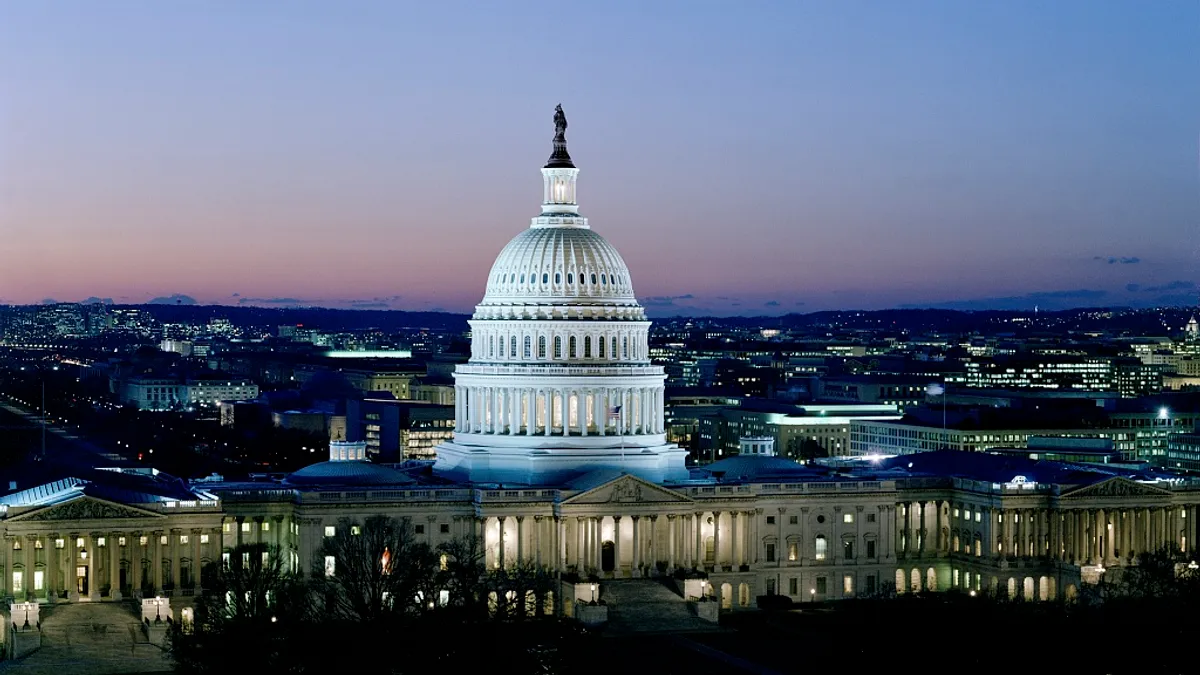Dive Brief:
- House Republicans unveiled a broad spending and tax legislation package on Tuesday night that includes multi-year extensions for federal tax incentives for wind and solar generation facilities. The tax extenders legislation would also lift the 40-year-old ban on crude oil exports from the U.S.
- Extensions for wind energy's $0.023/kWh production tax credit (PTC) and solar energy’s 30% federal investment tax credit (ITC) were pushed by Congressional Democrats in exchange for lifting the ban on crude exports, a policy change long sought by Republicans and the oil and gas sector.
- Under the tentative deal, the wind PTC would be extended through 2020 and would decline in value each year after December 2016 until it is phased out entirely. The solar ITC would be drawn down gradually through 2022.
- The tax extenders legislation was paired with a $1.1 trillion spending bill to fund the government through September 2016. A spokesperson for House Speaker Paul Ryan told Bloomberg that a schedule for floor debate on the bills would be announced this week.
Dive Insight:
While many Democrats and renewable energy adovcates oppose lifting the ban on oil exports imposed in 1975, Greentech Media reports they saw it as an opportunity to secure extensions for crucial tax incentives for wind and solar.
Democratic leaders said Monday they would not support any bill to lift the export ban if it did not include provisions to support renewables as well. Senate Minority Leader Harry Reid took to Twitter to draw a line in the sand:
We have 2 paths: 1. Pair oil export ban with policies to reduce carbon emissions 2. Pass govt funding without oil/renewables
— Senator Harry Reid (@SenatorReid) December 15, 2015
If the legislation passes through the House and Senate and is signed into law, both the wind and solar industries would receive five year extensions on their tax credits, although the structure of the programs would change.
Any wind facility that begins construction before 2020 could be eligibile for tax credits, Ed Einowski, a partner at the law firm Stoel Rives, said in an email to Utility Dive.
"However, if construction begins in 2017, the credit is reduced by 20%, 40% if construction begins in 2018, and 60% if construction begins in 2019," he wrote. "These changes do not apply to any technologies except wind."
Solar facilities that begin construction before 2020 could qualify for the full 30% ITC under the tentative deal, according to Gregory Jenner, the co-chair of the Stoel Rives energy team, but the credits would phase out after that.
"If construction begins in 2020, the facility qualifies for a 26% credit," he wrote. "If construction begins in 2021, the facility qualifies for a 22% credit."
Facilities with construction starting after 2021 — or if construction begins before 2022 but the facility is not placed in service before 2024 — would qualify for a 10% credit. Residential solar systems would receive the same credits, but they would apply when the system is placed in service, rather than when construction began, according to Jenner, a former Treasury Department tax official.
President Obama opposes lifting the oil export ban on its own, but The Hill reports the White House has indicated this week it might support a deal that extended support for renewable energy.
“We oppose legislation that would lift the ban on the exporting of American crude oil,” White House press secretary Josh Earnest said Monday. “But we certainly do want to see Congress — and hopefully they will in the context of this budget agreement — make the kinds of investments in renewable and clean energy that are good for our economy and have the potential to create good American middle-class jobs down the line.”
Environmentalists are against lifting the ban at all, warning of the climactic consequences of encouraging more fossil fuel use. The move would be a boon for the U.S. oil and gas industry, which is struggling as crude prices approach seven-year lows.
Extension of the tax credits is expected to have a significant impact on the deployment of wind and solar. When Congress failed to extend the wind PTC in 2013, development fell 92% and 30,000 wind industry jobs were lost. The 2014 restoration brought back 23,000 jobs, according to the wind industry.
For solar, Bloomberg New Energy Finance estimates that deployment would amount to 73 GW by 2022 without the ITC, but a five-year extension would result in 95 GW of installed capacity in that period.
Those numbers are likely to change given the modifications to the ITC in the deal, but Einowski expects the extensions to help eliminate some of the regulatory uncertainty surrounding renewable power.
"From the utilities perspective, it will also assist with the planning process many are involved in to displace fossil fuel loads with renewable power as it would take the pressure off to sign up renewables at favorable prices before the subsidies expire and permits a more measured approach," he wrote.














